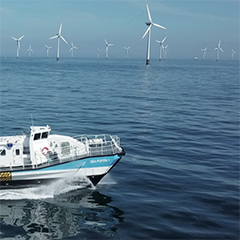Trygve Espeland, naval architect for the Norwegian ship design company ESNA is enthusiastic about new suppliers and equipment for the high-speed ship vessel sector. He gives PES his thoughts on the new, exciting, electric solutions for high speed vessels.
Electric propulsion solutions are something we have been looking at for many years, but there haven’t really been any good solutions suitable for weight sensitive high-speed vessels.
Electric solutions
The electric revolution in the Norwegian car ferry industry is booming, with an expected 60 zero emission electric ferries in operation by 2021. The key for these, compared to high speed vessels, is that the routes are short and the vessels are not weight sensitive. They can therefore easily transport heavy electric systems and batteries and charge the batteries often so the number of batteries installed can be low. These ferries are therefore very well suited to zero emission operation with batteries.
Within offshore support vessels, a dominating trend is diesel electric hybrid drives, – suitable for combination of propellers and thrusters used for DP operation. These have existed for some years now, but the same solutions are not suitable for smaller vessels because the equipment is very heavy and dimensioned for higher power.
With the recent developments, within the electric and hydrogen car and truck/bus industry, there now exists significantly lighter batteries and electric motors with power levels similar to high speed vessels. Several companies have seen this opportunity and are now offering alternatives appropriate for the marine industry. This means that we suddenly have many light weight electric generators, motors and inverters to choose from, making electric drive absolutely feasible for high speed vessels.
Energy storage and hybrid drive
We think that we can offer the completely zero emission, high speed vessel in the near future. However, the main challenge, which still needs to be solved is the weight of the energy storage.
A typical marine battery weighs 5-10kg/kWh, compared to the 0.2kg/kWh marine diesel fuel and 0.06kg/kWh for hydrogen. The hydrogen storage tanks typically weigh 25kg for each kg of hydrogen. For instance, the offshore wind crew transfer vessels need several thousand kWh for daily operation. If we, as an example, assume an optimistic 3,000 kWh you must install a minimum 15 tons of battery or close to 5 tons of hydrogen with tank, compared
to 600kg diesel. You must also include a reserve capacity.
In some cases, the energy consumption could be so low that hydrogen or battery are possible. However, in most cases where a high-speed vessel is needed to cover a long distance. This means the energy consumption is too high to justify the added weight of batteries or hydrogen tanks.



























